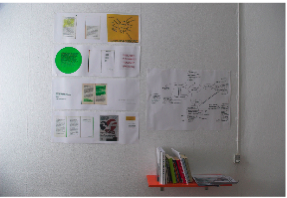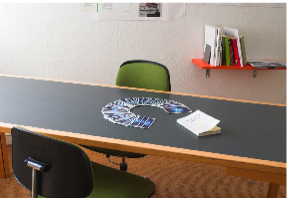WORKAFFAIR
a project
challenging and debating
social and political conceptions
of work
Oliver Ressler (A) & Dario Azzelini (I)
5 Factories–Worker Control in Venezuela, Film 81 min., 2006, english subtitles
Azzellini and Ressler focus on the industrial sector in “5 Factories–Worker Control in Venezuela“. The changes in Venezuela's productive sphere are demonstrated with five large companies in various regions: a textile company, aluminum works, a tomato factory, a cocoa factory, and a paper factory. In all, the workers are struggling for different forms of co- or self-management supported by credits from the government. “The assembly is basically governing the company”, says Rigoberto López from the textile factory “Textileros del Táchira” in front of steaming tubs. And coning machine operator Carmen Ortiz summarizes the experience as follows: “Working collectively is much better than working for another–working for another is like being a slave to that other”.
The protagonists portrayed at the five production locations present insights into ways of alternative organizing and models of workers' control. Mechanisms and difficulties of self-organization are explained as well as the production processes.
The protagonists portrayed at the five production locations present insights into ways of alternative organizing and models of workers' control. Mechanisms and difficulties of self-organization are explained as well as the production processes.
EXHIBITION RUM46 April 30th - May 7th 2007

RUM46
project and exhibition space
















Participants:
bankleer, (artistgroup, Germany), Oliver Ressler (artist, Austria), Kuba Szreder, (curator, Poland), Kristina Ask (artist, Denmark),
Sine Bang Nielsen (artist, Denmark), Anja Raithel & Grete Aagaard, (curator/artist, Denmark)
The participants present video works, installation, drawing, text all related to the themes of the seminar and extend the debate in a format of an exhibition.
Below: short work presentations under each documentation
- text on the individual participants please go to

exhibition
bankleer (DE)
deregulated, video, 9.30 min., 2005
The background of this piece are the constant calls for flexibilization and deregulation that are made in hopes of reviving the economy. The actual context of "deregulated being" tends however to be left out of consideration. As soon as the state encounters real deregulation, massive security measures are undertaken or a "social industry" is deployed to manage the deregulated situation.
bankleer (DE)
raus mit der arbeit rein mit der realität, video, 19.30 min., german.
Documentation of the installation and action week in the Stuttgart Employment Agency 2004 in collaboration with the unemployment initiatives Salz, Wut and Lagalo. The installation was a platform for daily actions during opening hours and shows the protest proliferating from the agency's office furniture exhumed from the storage room. Our goal is to make the effects of the legal changes visible in the places they are applied!
Kristina Ask (DK)
Drawing: Untitled
“The term blue-collar is derived from uniform dress codes of industrial workplaces. Industrial and manual workers wear durable clothing that can be soiled or scrapped at work. A popular element of such “work clothes” has been, and still is, a light or navy blue shirt.
“The term blue-collar is derived from uniform dress codes of industrial workplaces. Industrial and manual workers wear durable clothing that can be soiled or scrapped at work. A popular element of such “work clothes” has been, and still is, a light or navy blue shirt.
Blue is also a popular color for coveralls, and will usually carry a name tag of the company/establishment on one side, and the individual's name on the other. A more specific example would be Dickies brand clothes, which are often worn by blue collar workers who prefer durable clothing that is functional for hands-on jobs. It is not un-common to find a mechanic or construction worker dressed head-to-toe in Dickies work shirts and work pants, and often these items are bought by the company and laundered by the establishment as well. For footwear, the most common type worn by tradesmen and manual laborers are heavy duty steeled-tipped work boots, although the style may vary from person to person, work boots that are slip resistant seem to be the norm.
The popularity of the color blue among persons who do manual labor is contrasted to the ubiquitous white dress shirt that, historically, has been standard attire in office environments. This obvious color-coding has been used to identify a difference in socio-economic class. This distinction is growing more blurred, however, with the increasing importance of skilled labor, and the growth of non-laboring, but low-paying, service sector jobs.
Blue-collar can also be used as an adjective to describe the environment of the blue-collar worker: e.g. a blue-collar neighborhood, job, restaurant, bar, etc., or a situation describing the use of manual effort and the strength required to do so.[3]” http://en.wikipedia.org/wiki/Blue-collar_worker
Sine Bang Nielsen (DK)
Buisness Tarot
Business Tarot deals with language and the attempts of companies, via courses that often have religious or personal development training as a background, to tap into the hidden potential of employees. Business Tarot aims to show the linguistic fusion between New Age and modern management and, thus, a fusion between private, spiritual space and the labour market.
Research/text works:
co-operation with artist Sine Bang Nielsen (DK), Anja Raithel and Grete Aagaard.
co-operation with artist Sine Bang Nielsen (DK), Anja Raithel and Grete Aagaard.
LINK: NOTES AND RESEARCH - GO TO




Oliver Ressler (A)
“The Fittest Survive”
The video “The Fittest Survive” is based on filming the five-day course “Surviving Hostile Regions” done in January 2006 in Wales, Great Britain by the AKE Group. The course instructors are British ex-special force soldiers. The participants are businessmen who are preparing for business in Iraq and other dangerous regions, government officials and mainstream journalists who, with their dishonest discourse of democracy and human rights, help to legitimise and secure the ideology of market-economics expansion.

